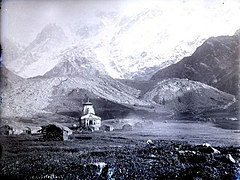ਕੇਦਾਰਨਾਥ
Kedarnath
Kedarkhand | |
|---|---|
Town | |
 A view of Kedarnath | |
| ਗੁਣਕ: 30°44′N 79°04′E / 30.73°N 79.07°E | |
| Country | |
| State | ਤਸਵੀਰ:..Uttarakhand Flag(INDIA).png Uttarakhand |
| ਨਾਮ-ਆਧਾਰ | Kedarnath Temple |
| ਖੇਤਰ | |
| • ਕੁੱਲ | 2.75 km2 (1.06 sq mi) |
| ਉੱਚਾਈ | 3,583 m (11,755 ft) |
| ਆਬਾਦੀ (2011) | |
| • ਕੁੱਲ | 612 |
| • ਘਣਤਾ | 220/km2 (580/sq mi) |
| Language | |
| • Official | Hindi[1] |
| • Additional official | Sanskrit[2][3] |
| • Regional | Garhwali |
| ਸਮਾਂ ਖੇਤਰ | ਯੂਟੀਸੀ+5:30 (IST) |
| Pin Code | 246445 |
| ਵਾਹਨ ਰਜਿਸਟ੍ਰੇਸ਼ਨ | UK-13 |
| ਵੈੱਬਸਾਈਟ | badrinath-kedarnath |
ਕੇਦਾਰਨਾਥ ਭਾਰਤ ਦੇ ਉੱਤਰਾਖੰਡ ਰਾਜ ਦੇ ਰੁਦਰਪ੍ਰਯਾਗ ਜ਼ਿਲ੍ਹੇ ਦਾ ਇੱਕ ਸ਼ਹਿਰ ਹੈ ਅਤੇ ਕੇਦਾਰ ਨਾਥ ਮੰਦਰ ਦੇ ਕਾਰਨ ਇਸਦਾ ਮਹੱਤਵ ਵਧਿਆ ਹੈ। ਇਹ ਜ਼ਿਲ੍ਹਾ ਹੈਡਕੁਆਟਰ ਰੁਦਰਪ੍ਰਯਾਗ ਤੋਂ ਲਗਭਗ 86 ਕਿਲੋਮੀਟਰ ਦੀ ਦੂਰੀ ਤੇ ਹੈ। ਇਹ ਰੁਦਰਪ੍ਰਯਾਗ ਜ਼ਿਲ੍ਹੇ ਵਿੱਚ ਇੱਕ ਨਗਰ ਪੰਚਾਇਤ ਹੈ। ਕੇਦਾਰਨਾਥ ਚਾਰ ਧਾਮ ਤੀਰਥ ਸਥਾਨਾਂ ਵਿਚੋਂ ਸਭ ਤੋਂ ਦੂਰ ਹੈ। ਇਹ ਹਿਮਾਲਿਆ ਵਿੱਚ, ਸਮੁੰਦਰ ਤਲ ਤੋਂ ਲਗਭਗ 3,583 ਮੀਟਰ (11,755 ਫੁੱਟ) ਦੀ ਉਚਾਈ 'ਤੇ ਚੋਰਾਬਾਰੀ ਗਲੇਸ਼ੀਅਰ ਦੇ ਨੇੜੇ ਸਥਿਤ ਹੈ, ਜੋ ਕਿ ਮੰਦਾਕਿਨੀ ਨਦੀ ਦਾ ਸਰੋਤ ਹੈ। ਇਹ ਸ਼ਹਿਰ ਬਰਫ ਨਾਲ ਢੱਕੀਆਂ ਚੋਟੀਆਂ ਨਾਲ ਘਿਰਿਆ ਹੋਇਆ ਹੈ, ਜੋ ਕਿ ਸਭ ਤੋਂ ਪ੍ਰਮੁੱਖ ਤੌਰ 'ਤੇ ਕੇਦਾਰਨਾਥ ਪਰਬਤ ਹੈ। ਸਭ ਤੋਂ ਨੇੜਲੀ ਸੜਕ ਦਾ ਸਿਰ ਲਗਭਗ ੧੬ ਕਿਲੋਮੀਟਰ ਦੀ ਦੂਰੀ 'ਤੇ ਗੌਰੀਕੁੰਡ ਵਿਖੇ ਹੈ। ਜੂਨ ੨੦੧੩ ਦੌਰਾਨ ਉੱਤਰਾਖੰਡ ਰਾਜ ਵਿੱਚ ਭਾਰੀ ਮੀਂਹ ਕਾਰਨ ਆਏ ਹੜ੍ਹਾਂ ਕਾਰਨ ਇਸ ਕਸਬੇ ਨੂੰ ਭਾਰੀ ਤਬਾਹੀ ਦਾ ਸਾਹਮਣਾ ਕਰਨਾ ਪਿਆ।
ਨਿਰੁਕਤੀ
[ਸੋਧੋ]ਕੇਦਾਰਨਾਥ ਨਾਮ ਦਾ ਅਰਥ ਹੈ "ਮੈਦਾਨ ਦਾ ਸੁਆਮੀ"। ਇਹ ਸੰਸਕ੍ਰਿਤ ਦੇ ਸ਼ਬਦ ਕੇਦਾਰਾ ("ਫੀਲਡ/ਮੈਦਾਨ") ਅਤੇ ਨਾਥਾ ("ਪ੍ਰਭੂ") ਤੋਂ ਲਿਆ ਗਿਆ ਹੈ। ਪਾਠ ਕਾਸ਼ੀ ਕੇਦਾਰਾ ਮਹਾਤਮਯ ਵਿੱਚ ਕਿਹਾ ਗਿਆ ਹੈ ਕਿ ਇਸ ਨੂੰ ਅਖੌਤੀ ਇਸ ਲਈ ਕਿਹਾ ਜਾਂਦਾ ਹੈ ਕਿਉਂਕਿ "ਮੁਕਤੀ ਦੀ ਫਸਲ" ਇੱਥੇ ਉੱਗਦੀ ਹੈ।[4]
ਇਤਿਹਾਸ
[ਸੋਧੋ]ਕੇਦਾਰਨਾਥ ਪ੍ਰਾਚੀਨ ਕਾਲ ਤੋਂ ਹੀ ਤੀਰਥ ਸਥਾਨ ਰਿਹਾ ਹੈ। ਮੰਦਰ ਦੀ ਉਸਾਰੀ ਦਾ ਸਿਹਰਾ ਮਹਾਭਾਰਤ ਵਿੱਚ ਜ਼ਿਕਰ ਕੀਤੇ ਪਾਂਡਵ ਭਰਾਵਾਂ ਨੂੰ ਜਾਂਦਾ ਹੈ।[5][6] ਹਾਲਾਂਕਿ, ਮਹਾਭਾਰਤ ਵਿੱਚ ਕੇਦਾਰਨਾਥ ਨਾਮ ਦੀ ਕਿਸੇ ਵੀ ਜਗ੍ਹਾ ਦਾ ਜ਼ਿਕਰ ਨਹੀਂ ਹੈ। ਕੇਦਾਰਨਾਥ ਦਾ ਸਭ ਤੋਂ ਪੁਰਾਣਾ ਹਵਾਲਾ ਸਕੰਦ ਪੁਰਾਣ (ਲਗਭਗ 7 ਵੀਂ-8 ਵੀਂ ਸਦੀ) ਵਿੱਚ ਮਿਲਦਾ ਹੈ, ਜਿਸ ਵਿੱਚ ਕੇਦਾਰਾ (ਕੇਦਾਰਨਾਥ) ਦਾ ਨਾਮ ਉਸ ਸਥਾਨ ਵਜੋਂ ਰੱਖਿਆ ਗਿਆ ਹੈ ਜਿੱਥੇ ਭਗਵਾਨ ਸ਼ਿਵ ਨੇ ਆਪਣੇ ਜਟਾਂ ਵਾਲੇ ਵਾਲਾਂ ਤੋਂ ਗੰਗਾ ਦੇ ਪਵਿੱਤਰ ਜਲ ਨੂੰ ਛੱਡਿਆ ਸੀ, ਜਿਸ ਦੇ ਨਤੀਜੇ ਵਜੋਂ ਗੰਗਾ ਨਦੀ ਦਾ ਨਿਰਮਾਣ ਹੋਇਆ ਸੀ।[7]
ਟਿਕਾਣਾ/ਲੋਕੇਸ਼ਨ
[ਸੋਧੋ]
ਕੇਦਾਰਨਾਥ ਉਤਰਾਖੰਡ ਦੇ ਰਿਸ਼ੀਕੇਸ਼ ਤੋਂ 223 ਕਿਲੋਮੀਟਰ ਦੀ ਦੂਰੀ 'ਤੇ ਅਤੇ ਸਮੁੰਦਰ ਤਲ ਤੋਂ 3,583 ਮੀਟਰ (11,755 ਫੁੱਟ) ਦੀ ਉਚਾਈ 'ਤੇ ਮੰਦਾਕਿਨੀ ਨਦੀ ਦੇ ਸਰੋਤ ਦੇ ਨੇੜੇ ਸਥਿਤ ਹੈ। ਟਾਊਨਸ਼ਿਪ ਮੰਦਾਕਿਨੀ ਨਦੀ ਦੇ ਕੰਢੇ 'ਤੇ ਜ਼ਮੀਨ ਦੇ ਬੰਜਰ ਹਿੱਸੇ' ਤੇ ਬਣਾਈ ਗਈ ਹੈ।[8] ਹਿਮਾਲਿਆ ਅਤੇ ਹਰੇ ਚਰਾਗਾਹਾਂ ਦੇ ਆਲੇ-ਦੁਆਲੇ ਦੇ ਨਜ਼ਾਰੇ ਇਸ ਨੂੰ ਤੀਰਥ ਯਾਤਰਾ ਅਤੇ ਟਰੈਕਿੰਗ ਲਈ ਬਹੁਤ ਹੀ ਆਕਰਸ਼ਕ ਸਥਾਨ ਬਣਾਉਂਦੇ ਹਨ। ਸ਼ਹਿਰ ਅਤੇ ਕੇਦਾਰਨਾਥ ਮੰਦਰ ਦੇ ਪਿੱਛੇ, 6,940 ਮੀਟਰ (22,769 ਫੁੱਟ) ਦੀ ਸ਼ਾਨਦਾਰ ਕੇਦਾਰਨਾਥ ਚੋਟੀ, 6,831 ਮੀਟਰ (22,411 ਫੁੱਟ) 'ਤੇ ਕੇਦਾਰ ਗੁੰਬਦ ਅਤੇ ਇਸ ਰੇਂਜ ਦੀਆਂ ਹੋਰ ਚੋਟੀਆਂ 'ਤੇ ਖੜ੍ਹਾ ਹੈ।[9][10]
ਦਿਲਚਸਪੀ ਵਾਲੇ ਸਥਾਨ
[ਸੋਧੋ]ਕੇਦਾਰਨਾਥ ਮੰਦਰ ਤੋਂ ਇਲਾਵਾ, ਸ਼ਹਿਰ ਦੇ ਪੂਰਬੀ ਪਾਸੇ ਭੈਰਵਨਾਥ ਮੰਦਰ ਹੈ, ਅਤੇ ਮੰਨਿਆ ਜਾਂਦਾ ਹੈ ਕਿ ਇਸ ਮੰਦਰ ਦਾ ਦੇਵਤਾ, ਭੈਰਵਨਾਥ, ਸਰਦੀਆਂ ਦੇ ਮਹੀਨਿਆਂ ਦੌਰਾਨ ਸ਼ਹਿਰ ਦੀ ਰੱਖਿਆ ਕਰਦਾ ਹੈ। ਸ਼ਹਿਰ ਤੋਂ ਲਗਭਗ 6 ਕਿਲੋਮੀਟਰ ਉੱਪਰ ਵੱਲ, ਚੋਰਾਬਾਰੀ ਤਾਲ ਸਥਿਤ ਹੈ, ਜੋ ਇੱਕ ਝੀਲ ਅਤੇ ਗਲੇਸ਼ੀਅਰ ਹੈ ਜਿਸ ਨੂੰ ਗਾਂਧੀ ਸਰੋਵਰ ਵੀ ਕਿਹਾ ਜਾਂਦਾ ਹੈ। ਕੇਦਾਰਨਾਥ ਦੇ ਨੇੜੇ, ਭੈਰਵ ਝੰਪ ਨਾਂ ਦੀ ਇੱਕ ਚਟਾਨ ਹੈ। ਦਿਲਚਸਪੀ ਦੇ ਹੋਰ ਸਥਾਨਾਂ ਵਿੱਚ ਕੇਦਾਰਨਾਥ ਵਾਈਲਡ ਲਾਈਫ ਸੈੰਕਚੂਰੀ, ਆਦਿ ਸ਼ੰਕਰਾਚਾਰੀਆ ਸਮਾਧੀ ਅਤੇ ਰੁਦਰ ਧਿਆਨ ਗੁਫਾ ਸ਼ਾਮਲ ਹਨ।[11]
-
Kedarnath in the 1860s, with the temple being the prominent structure.
-
Lord Bhairavnath Ji considered as the Protector God of the area
-
The Kedarnath Temple in 2014, one year after the floods.
-
The Mandakini River on the bank of the town
ਇਹ ਵੀ ਦੇਖੋ
[ਸੋਧੋ]
ਹਵਾਲੇ
[ਸੋਧੋ]- ↑ "Report of the Commissioner for linguistic minorities: 50th report (July 2012 to June 2013)" (PDF). Commissioner for Linguistic Minorities, Ministry of Minority Affairs, Government of India. Archived from the original (PDF) on 8 July 2016. Retrieved 7 December 2020.
- ↑ Trivedi, Anupam (19 January 2010). "Sanskrit is second official language in Uttarakhand". Hindustan Times. Archived from the original on 1 February 2012. Retrieved 30 August 2017.
- ↑ "Sanskrit second official language of Uttarakhand". The Hindu. 21 January 2010. Archived from the original on 3 March 2018. Retrieved 30 August 2017.
- ↑ Diana L. Eck (2013). Banaras: City of Light. Knopf Doubleday. pp. 185–186. ISBN 978-0-307-83295-5.
- ↑ J. Gordon Melton; Martin Baumann, eds. (2010). Religions of the World: A Comprehensive Encyclopedia of Beliefs and Practices. Vol. 1 (A-B) (2nd ed.). ABC-CLIO. p. 1624. ISBN 978-1-59884-204-3.
- ↑ James G. Lochtefeld (2002). The Illustrated Encyclopedia of Hinduism: A-M. Rosen. pp. 363–364. ISBN 978-0-8239-3179-8.
- ↑ Alex McKay (2015). Kailas Histories: Renunciate Traditions and the Construction of Himalayan Sacred Geography. BRILL. p. 135. ISBN 978-90-04-30618-9.
- ↑ Abram, David (2003). The Rough guide to India (2003 ed.). New York: Rough Guides. pp. 354–355. ISBN 9781843530893.
- ↑ Abram, David (2003). The Rough guide to India (2003 ed.). New York: Rough Guides. pp. 354–355. ISBN 9781843530893.
- ↑ Kala, CP (2014). "Deluge, disaster and development in Uttarakhand Himalayan region of India: challenges and lessons for disaster management". International Journal of Disaster Risk Reduction. 8: 143–152. doi:10.1016/j.ijdrr.2014.03.002.
- ↑ "Kedarnath | Char Dham | Uttarakhand Tourism". namasteindiatrip.com. Retrieved 4 March 2022.






